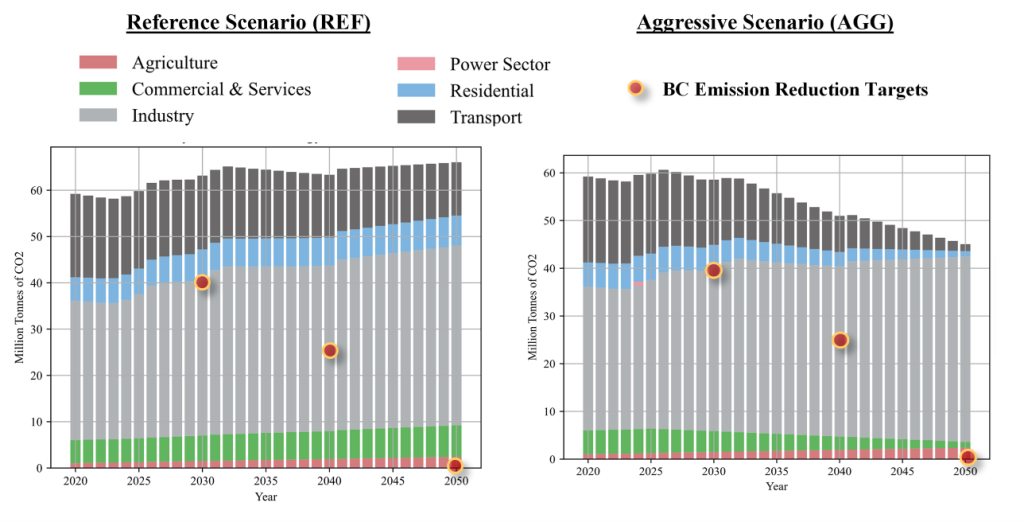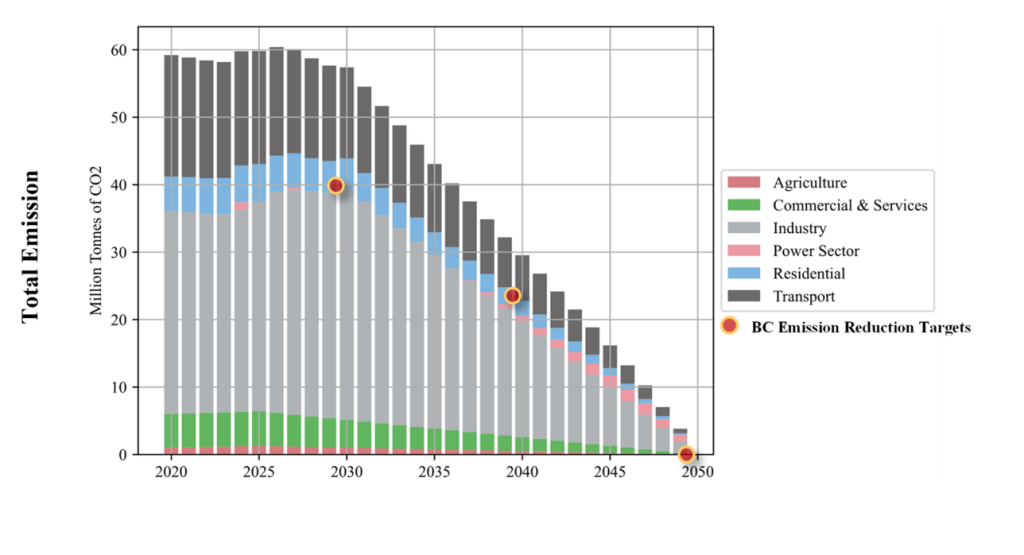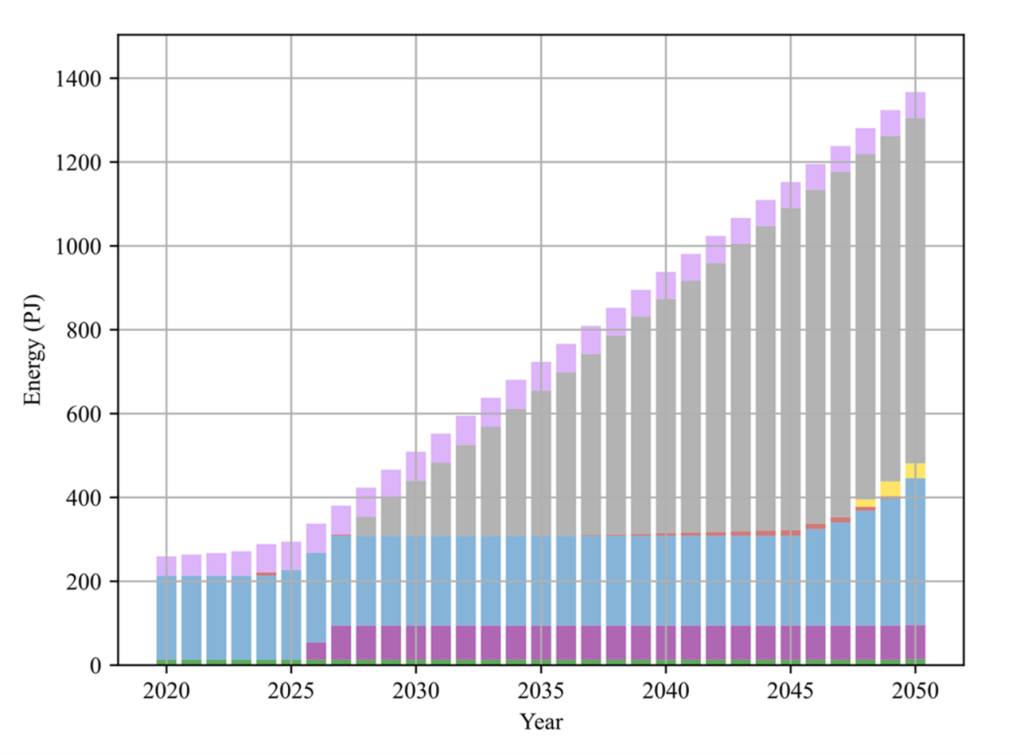A January 2024 study raises interesting and timely questions about BC’s energy transition. The study was recently presented by Dr. Nastaran Arianpoo, PhD, lead researcher on the BC Nexus Modelling project undertaken by Simon Fraser University’s Delta-e-Plus research group.
BC’s climate change goals
The 2007 Climate Change Accountability Act established targets for greenhouse gas (GHG) emission reductions in BC (all compared to a baseline in 2007):
- 40 percent by 2030;
- 60 percent by 2040; and
- 80 percent by 2050.
In the CleanBC Roadmap to 2030, issued in December 2021, the Minister of Environment and Climate Change Strategy also refers to a “net-zero commitment by 2050.”
The study looks at how electrification could achieve these goals, and the consequences for electricity costs and land use in BC.
Will aggressive electrification be enough?
The study looked at three scenarios:
- A reference or “business-as-usual” scenario, assuming a low electrification rate;
- An aggressive electrification scenario, where natural gas is eliminated from the residential and commercial sectors and 50 percent of passenger cars and transit vehicles are electrified; and
- A 100 percent electrification scenario, where BC’s net zero target by 2050 is met through electrification.
The study used the BC Nexus Model, which simulates the interactions between climate, land, energy and water systems in the province. The team fed the model with assumptions about how much wind, solar, biofuel and other energy sources are available in BC, and asked it to find the cheapest mix to meet the energy goals.
The good news is that aggressive electrification would lead to a reduction in GHG emissions compared to 2020, unlike the business-as-usual case. The bad news, though, is it doesn’t come close to meeting the government’s GHG emission reduction targets, let alone the net-zero goal for 2050.
Figure 1: GHG emissions in the reference and aggressive scenarios. Red circles indicate the provincial emission reduction targets in 2030, 2040, and 2050.

100 percent electrification
The study team couldn’t find any way to reach the government’s interim GHG emission reduction goals for 2030 and 2040 with electrification, and concluded that achieving these goals would be “unlikely”. It did, however, see a way of achieving the 2050 goal of net zero GHG emissions:
Figure 2: GHG emissions in the 100 percent electrification scenario. Red circles indicate the provincial emission reduction targets in 2030, 2040, and 2050.

Achieving net-zero GHG emissions by 2050 with electrification requires about four times our current ability to generate electricity in BC, which would require adding the equivalent of between 60 and 80 Site C dams. Where would this electricity come from?
The study found that relying solely on wind and solar energy for 100 percent electrification was not feasible due to limited availability and their intermittent nature, which lacks consistent “baseload” or reliable energy. Further, the limited geothermal and bio-fuel resources in the province also constrain the technology choices.
The nuclear option
Choosing the lowest cost options first, the model predicts that to achieve net-zero GHG emissions by 2050, we would use BC’s untapped geothermal energy…and then a lot of nuclear power.
Figure 3: The power system technology mix to 2050 in the 100 percent electrification scenario.


Noting the “negative publicity for certain technologies, such as nuclear and large hydropower projects in Canada”, the study examined options that limited the amount of nuclear power used. A cap of 4 GW on nuclear power failed to achieve net-zero GHG emissions by 2050, but a cap of 10 GW did – at a cost. The alternative to the electricity from nuclear power was made up for by solar energy, using more than twice the amount of additional land. And this land is mostly in the south and southeast of BC, conflicting with agricultural and other uses.
Similarly, the study notes a “political reluctance” to the use of geothermal power in Canada. Modeling the effects of not using geothermal power, the study concludes we would use more hydro and solar energy, again more than doubling the use of land as a result.
The study concludes that the energy transition may end up occupying as much as six times the current amount of built-up land in the province.
Natural gas
While the study does not show natural gas being used to generate electricity by 2050, natural gas does play a role in keeping costs down. Natural gas turns out to be the cheapest option to provide “reserve margin”, insurance for times when demand is unexpectedly high, as the diagram below shows:
Figure 4: The power generation capacity required to 2050 in the 100 percent electrification scenario.


Cost implications
Land use isn’t the only consequence of achieving net-zero GHG emissions through electrification. The study predicts a four-fold increase in electricity costs by 2050, using the lowest cost options available, particularly nuclear energy. Limiting the use of nuclear power to 10 GW would cause electricity costs to rise five-fold.
Analysis
The study has its limitations, as the team acknowledges. The BC Nexus Model does not include energy storage technologies or energy trading with our neighbours, for example.
But as is often said, all models are wrong, but some are useful. Notwithstanding its limitations, the study raises some important questions about our current energy transition.
First, just how much should we rely on electrification as part of the energy transition? Electrification will surely be a key contributor, but as BC Hydro itself acknowledges, the utility only provides 19 percent of the province’s energy needs today. As this study shows, if we rely 100 percent on electrification to provide the other 81 percent, we may need to quadruple BC Hydro’s generating capacity. Are we ready for the scale of investment needed to add 60 to 80 Site C’s worth of generating capacity?
Second, to whatever extent we choose to rely on electrification, we need to face up to the trade-offs involved. Nuclear power has long been unpopular in BC, but as the study shows, there are costs to this choice, both in increased electricity costs and the use of valuable land. Newer technologies, such as molten salt reactors, are emerging that make nuclear power even safer than it is today. And we should also examine the “political reluctance” to using geothermal energy. It is important to understand the implications of these social and political biases before committing to the significant investment required for electrification.
Third, if we’re not willing to quadruple the size of BC Hydro, we need to make sure we continue to support the clean-up of alternative sources of energy, such as natural gas. As a previous article explained, there are suggestions the BC government intends to replace fossil fuels entirely. This is probably unrealistic. The study’s aggressive electrification scenario, which assumes we have eliminated all residential and consumer use of natural gas, still leads to a doubling of electricity costs, and doesn’t come close to meeting the government’s GHG emission reduction targets.
Fourth, the study’s results are quite different to BC Hydro’s view of the world. In its most recent forecast for “accelerated electrification”, which the utility states is sufficient to meet the government’s GHG emission reductions target by 2040, BC Hydro anticipates it will need 89,928 GWh (323.7 PJ) of energy by fiscal year 2040. The study’s results suggest that BC Hydro will need almost three times that amount. BC Hydro based its forecasts on a different model, Navius. Only time will tell which of these forecasts is more correct.
Finally, what is the BCUC’s role in all this?
I will explore these questions in more depth in coming weeks, as I review the BCUC’s recent decisions on BC Hydro’s Integrated Resource Plan and FortisBC Inc.’s long-term gas resource plan. Spoiler alert: you won’t find any discussion of nuclear or geothermal energy in either of them.
Acknowledgements
I would like to thank Dr. Arianpoo for her assistance in the preparation of this article. Any errors are mine, not hers. Also, I would like to acknowledge the Pacific Energy Innovation Association, at whose meeting Dr. Arianpoo presented her study.


